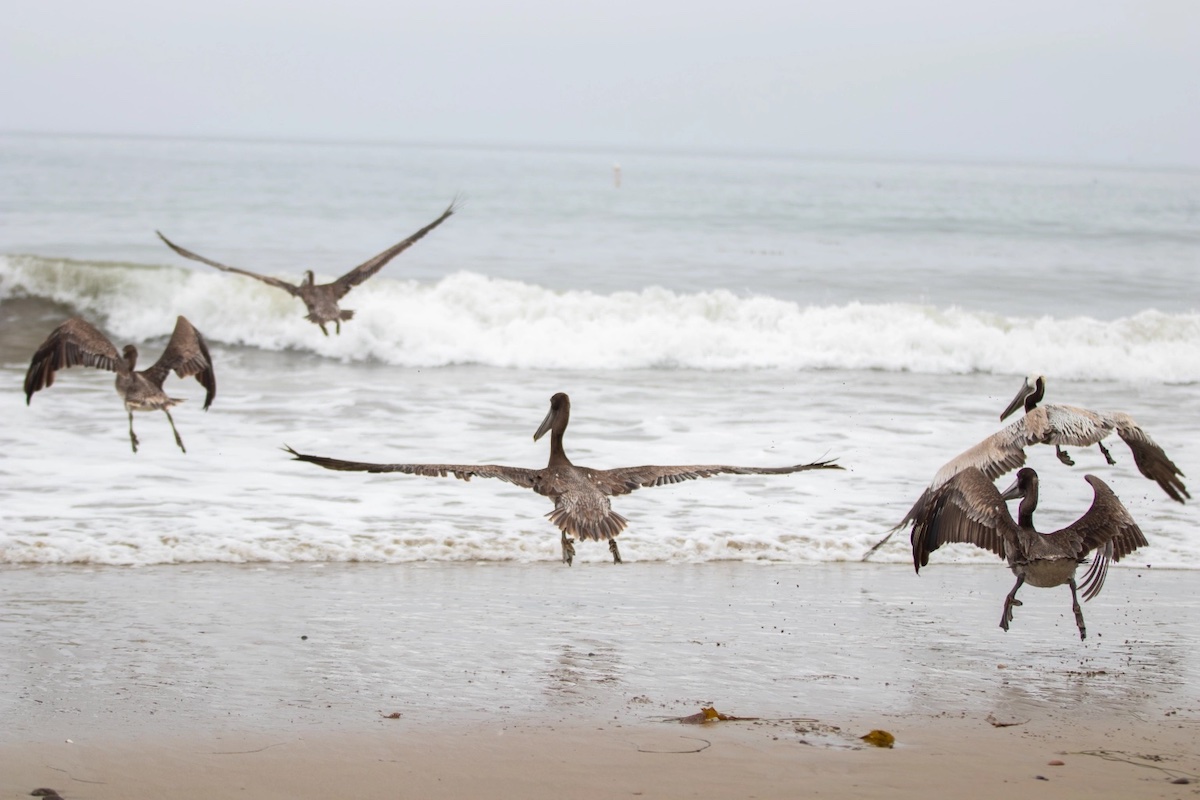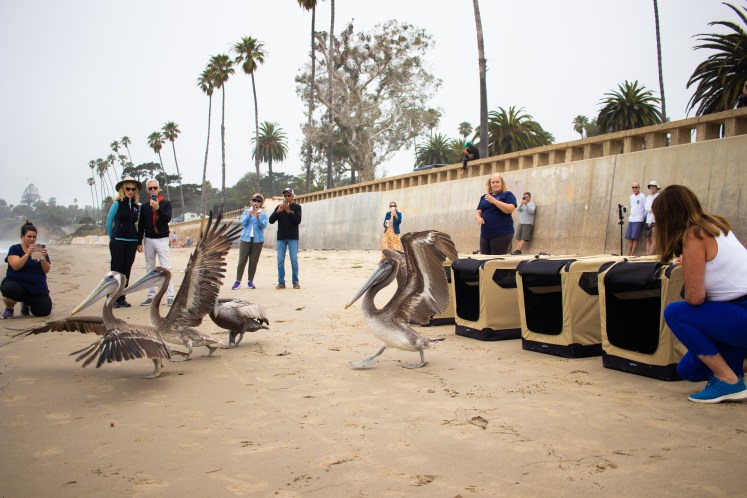Ten Brown Pelicans Released Back to the Wild in Montecito and Goleta
Santa Barbara Wildlife Care Network Still Treating 60 of the 260 Sick Seabirds Taken In over Past Month

It wasn’t quite a scene out of the movie Born Free, but it might have been the next best thing.
This past week, the Santa Barbara Wildlife Care Network released 10 of the hundreds of underfed and emaciated brown pelicans they’d been caring for the better part of the last month. Five of the birds were hauled in crates to Butterfly Beach in Montecito and another five at Goleta Beach. When the crates opened, some of the birds “flopped out” and walked along the sand for a few minutes before entering and swimming out. Others would fly off almost immediately, said Ariana Katovich, Wildlife Care Network executive director.
“It was never the same twice,” she said. “It was really rewarding to see them go free back to the wild.”
In the past month, Katovich said her organization has taken in 260 ailing brown pelicans. Some of those have been transferred to the San Pedro International Bird Rescue organization, which has bigger facilities. She said the Wildlife Care Network is still treating 60 birds. She estimated the survival rate of the rescued birds is 70 percent.

Katovich said the birds have been repeatedly tested for a number of ailments but that no cause has been nailed down yet. It’s not the avian flu, she stated, and it’s not a parasite either. Something, she said, is interfering with the pelicans and their food supply. What that is, she doesn’t pretend to know. But all the rescued birds are decidedly underweight and “very, very hungry.” They like to eat herring, smelt, and sardines.
Katovich said she’s been impressed by the outpouring of interest and generosity she’s experienced from members of the community. It takes a lot of care to bring the brown pelicans back. Before they can be released, Katovich said, they must be examined to ensure they are capable of remaining waterproof. Otherwise, they could die of hypothermia. They also must be able to fly. The Wildlife Care Network operates a large aviary equipped with multiple perches, so the birds’ ability to fly can be screened. When examining a pelican, a towel or sheet is typically placed over their head to keep them calm and secure. A little feistiness isn’t necessarily a bad indication, said Katovich, but most of the rescued pelicans were more docile, she added.
Sign up for Indy Today to receive fresh news from Independent.com, in your inbox, every morning.
Katovich said she’s had occasion to learn more about pelicans than she ever thought she wanted to know. The oldest brown pelican on record, she said, lived to be 43 years old. Most make to their thirties. Brown pelican fossils, she said, date back millions and millions of years.
“Just being around them, you get the sense they’re prehistoric,” she said.
Santa Barbara’s brown pelican is one of only two species of the bird that plunge dive into the ocean for food. And the pouch under the pelicans’ bills holds three times as much water as their stomachs.
All native brown pelicans breed and roost on Anacapa Island. It’s not clear if that’s where these birds come from or not, Katovich said. It’s possible they come from as far away as Mexico. Katovich said this is not the first time brown pelicans have experienced significant distress, just the most striking and intense. Sick birds have been found as far south as San Diego County and as far north as Monterey and Santa Cruz, but the vast majority have been picked up in Santa Barbara and Ventura counties. If there was something happening in the waters off the coast to disrupt the birds’ food supply, it’s not having an impact on any other species right now. Most of the brown pelicans being rescued are 2 years old, Katovich said, so it’s not just the hatchlings.
In the meantime, it’s baby season for many mammals and songbirds in Santa Barbara, meaning that this is the busiest time of year for the Wildlife Care Network. There’s no shortage of baby birds that have to be nursed back, Katovich said, not to mention baby raccoons, skunks, possum, and squirrels.
Support the Santa Barbara Independent through a long-term or a single contribution.




You must be logged in to post a comment.